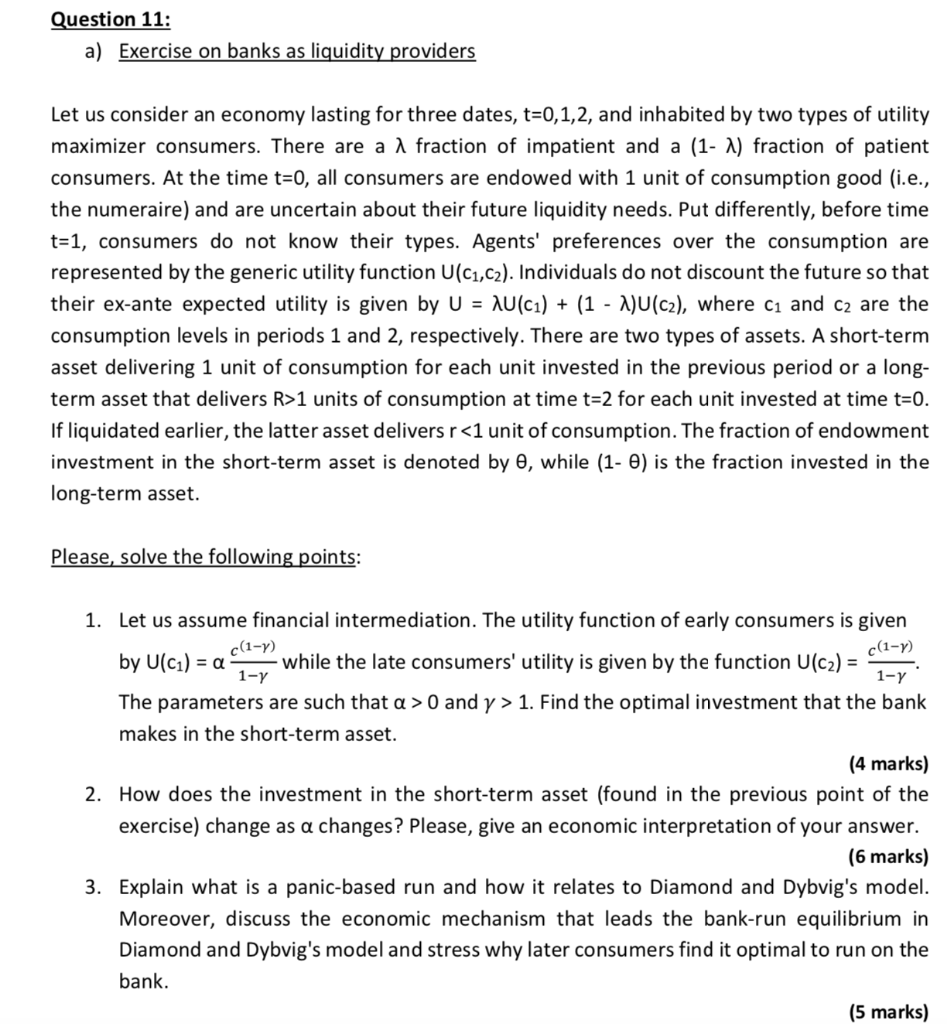
Question 11: a) Exercise on banks as liquidity providers Let us consider an economy lasting for three dates, t=0,1,2, and inhabited by two types of utility maximizer consumers. There are a 1 fraction of impatient and a (1-1) fraction of patient consumers. At the time t=0, all consumers are endowed with 1 unit of consumption good (i.e., the numeraire) and are uncertain about their future liquidity needs. Put differently, before time t=1, consumers do not know their types. Agents' preferences over the consumption are represented by the generic utility function U(C1,C2). Individuals do not discount the future so that their ex-ante expected utility is given by U = AU(c1) + (1 - 1)U(cz), where ci and C2 are the consumption levels in periods 1 and 2, respectively. There are two types of assets. A short-term asset delivering 1 unit of consumption for each unit invested in the previous period or a long- term asset that delivers R>1 units of consumption at time t=2 for each unit invested at time t=0. If liquidated earlier, the latter asset delivers r 0 and y > 1. Find the optimal investment that the bank makes in the short-term asset. (4 marks) 2. How does the investment in the short-term asset (found in the previous point of the exercise) change as a changes? Please, give an economic interpretation of your answer. (6 marks) 3. Explain what is a panic-based run and how it relates to Diamond and Dybvig's model. Moreover, discuss the economic mechanism that leads the bank-run equilibrium in Diamond and Dybvig's model and stress why later consumers find it optimal to run on the bank. (5 marks) Question 11: a) Exercise on banks as liquidity providers Let us consider an economy lasting for three dates, t=0,1,2, and inhabited by two types of utility maximizer consumers. There are a 1 fraction of impatient and a (1-1) fraction of patient consumers. At the time t=0, all consumers are endowed with 1 unit of consumption good (i.e., the numeraire) and are uncertain about their future liquidity needs. Put differently, before time t=1, consumers do not know their types. Agents' preferences over the consumption are represented by the generic utility function U(C1,C2). Individuals do not discount the future so that their ex-ante expected utility is given by U = AU(c1) + (1 - 1)U(cz), where ci and C2 are the consumption levels in periods 1 and 2, respectively. There are two types of assets. A short-term asset delivering 1 unit of consumption for each unit invested in the previous period or a long- term asset that delivers R>1 units of consumption at time t=2 for each unit invested at time t=0. If liquidated earlier, the latter asset delivers r 0 and y > 1. Find the optimal investment that the bank makes in the short-term asset. (4 marks) 2. How does the investment in the short-term asset (found in the previous point of the exercise) change as a changes? Please, give an economic interpretation of your answer. (6 marks) 3. Explain what is a panic-based run and how it relates to Diamond and Dybvig's model. Moreover, discuss the economic mechanism that leads the bank-run equilibrium in Diamond and Dybvig's model and stress why later consumers find it optimal to run on the bank







